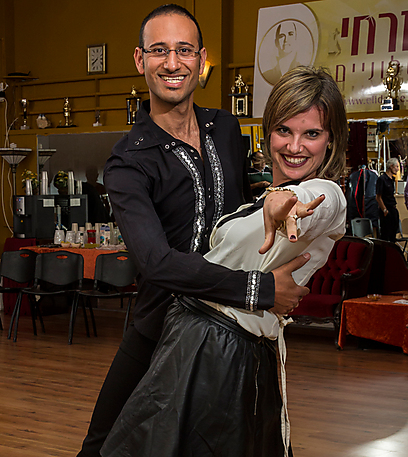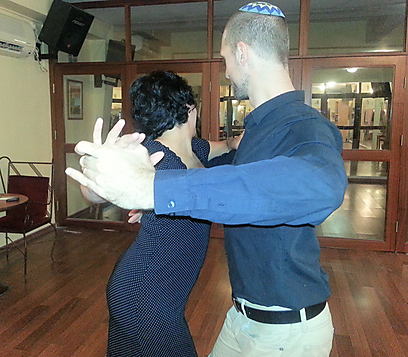"In Buenos Aires I saw a tango performance, and that's where my mouth opened and failed to close – it was amazing, and I decided that I wanted to bring that into my life," he says.
Upon his return to Israel, Eliyahu decided to give up on his military career and registered for the Eli Mizrahi Ballroom Dance School. Mizrahi took notice of the young religious man's talent and enthusiasm, and suggested that he specialize in the field.
At the same time, Eliyahu received a job offer at the Defense Ministry but shoes the first option, surprising his acquaintances.
"Even today, when I tell people what I do for a living, they usually raise an eyebrow in wonder – how can a religious guy be a dancing teacher?" he says.

'I find a religious aspect in dancing.' Nir and Meital Eliyahu (Photo: Leon Sokoletski)
Since then, Eliyahu and his wife Meital have become the owners of the Jerusalem branch of the Eli Mizrahi Ballroom Dance Schools, and he is one of the only teachers in Israel who can get members of the conservative faction of his sector to dance.
"More and more religious couples are coming here, because they want to spend time together," he says. According to Eliyahu, about 40% of the couples dancing in the studio are religious, and the teachers adapt to the restrictions of Halacha.
In order to create a modest environment, the teachers in the studio adhere to a strict dress code: The men wear suits and ties and the teachers avoid wearing vests.
"Dancing can be linked with immorality, and it's important for us that the studio is respectable, and perhaps that's the reason why religious people feel comfortable in it. In addition, due to the ritual purification laws, on weeks when couples can't dance together they arrive separately for men-only or women-only classes."
Anything below chest doesn't exist
One of the religious couples dancing at the studio are Hagai and his wife, who prefer not to reveal their full names. They have been married for 11 years and have four children, but only recently took the courage and decided to try out dances for couples.
The desire to dance was his, and he did not immediately succeed in convincing his wife to join him.

On weeks when couples cannot dance together, they arrive separately for men-only or women-only classes (Photo: Leon Sokoletski)
"As a religious guy I was very embarrassed, but because I have been in the acting field for years, and my body is an instrument for me – it was easier for me than for my wife," he says.
"Ballroom dancing is not something innocent, it's dealing with one's body, and I just informed my wife that we were going – because if not with her, who would I dance with?"
Hagai, 39, first became familiar with the world of dancing as part of acting classes at a religious theater called Aspaklaria.
"I learned dancing only with boys, and it was a bit ridiculous," he says. "The religious society has an unresolved issue with the body. Even when I studied acting, the secular teachers used to tell us that we're like news anchors: Everything below the chest doesn't exist for us."
Hagai and his wife don't dance with other couples, but only with each other. "There are parties in the studio in which many couples dance together. It's not suitable for us," says Hagai.
Another obstacle faced by religious couples who dance every week is the days of Niddah, when a woman goes through menstruation. "We have days when we are forbidden, and it's very embarrassing explaining it. But because the teacher is religious, he doesn't ask unnecessary questions."
According to Hagai, despite the limitations imposed by religion, he insisted on learning ballroom dancing because of the work accompanying it. "In ballroom dancing there is an issue of listening and accuracy. The work in the studio is basically on a relationship. It's an opportunity in daily life to look each other in the eyes."
Rabbi shows enthusiasm
Liat and Roee, who became religious together and define themselves as haredim, dance in the Nir Eliyahu studio as well. According to Liat, they have both always loved to dance, but since drawing closer to religion the number of opportunities has decreased.
When they celebrated their 10th wedding anniversary, Liat looked for a unique way to mark the occasion. They arrived at Nir and Meital's studio after a long search.
"I called a lot of places in Jerusalem and inquired whether there was a possibility to come in for a personal course, because we can't dance with other men and women. When Meital answered the phone, she immediately understood what I was looking for," says Liat.
Since then, Liat and Roee have been taking classes with a private teacher, in order to avoid a situation in which Liat dances in front of a man who is not her husband. She says that the fact the teacher also avoided dancing and dressed modestly made the couple feel comfortable. Although they didn't take part in the parties held in the studio, the training at home was as fun, they say.
"When we practiced the children would watch us, and then I would grab one child and Roee would grab another child, and we would all dance together."
Despite the great enjoyment the two experience and despite being strict about Halacha rules, Liat and Roee prefer to remain anonymous. In the haredi society, Liat says, ballroom dancing is completely off limits. She clarifies, however, that they have received the rabbi's approval.
"We once went to our rabbi's lesson after a dancing class. When I told him where we had come from, he was really enthusiastic about it."
Liat notes that during classed they mostly enjoy the fact that they are spending time together actively. "The dancing is like couples therapy," she says. "For example, you must understand that the man leads the dance, and it took me time to let go and let him lead. The teacher has been working with us on it a lot."
Man is frame, woman is picture
Eliyahu understands what Liat is talking about very well. "As opposed to other dancing styles, here if you're not attentive to your partner – it's worthless," he says.
"In order to dance together, the couple must learn to listen or lead. These are concepts you meet in any type of relationship in life – even between employee and employer."
"We have slightly lost femininity and masculinity," adds Meital. "If I look at women today, they are very independent and leading and have an opinion. In dancing the man is the frame and the woman is the picture. In our studio, the woman learns to be a woman."
Nir and Meital owe their relationship to dancing too. "Dancing created contact between us," says Meital. "We were both looking for someone religious but open to the world of dancing, who would agree to mixed dancing. That's why the connection between us was so right."
Meital, who studied for a first degree in dancing, criticizes the perception of the body in the sector she belongs to. "The religious society drives girls away from their body," she says. "Nir and I are religious, but the thought that leads us in life is that there must be a connection between body and soul."
"The connection to the body and regaining control of it are a very big gift," Nir adds. "The dance floor simulates life. Many come to us when they realize that they have a problem finding a partner.
"In our generation the man is in a very complicated situation. He has to be tough, but also sensitive, and in addition the woman wants to face someone she can lean on. Through tango, for example, I help many men connect to their charisma, because you can't dance tango softly."
Nir says that 10 years after choosing to devote himself to dancing, he has no regrets. "There were many people who raised an eyebrow over the path I took, but today I laugh at all of them.
"We have our own business, in which we also dance and also help people go through internal processes. I don't know if an accountant, who deals with money all day, is more religious than me. For me, dancing has a religious aspect because it contains tolerance and attentiveness and an ability to help others."















